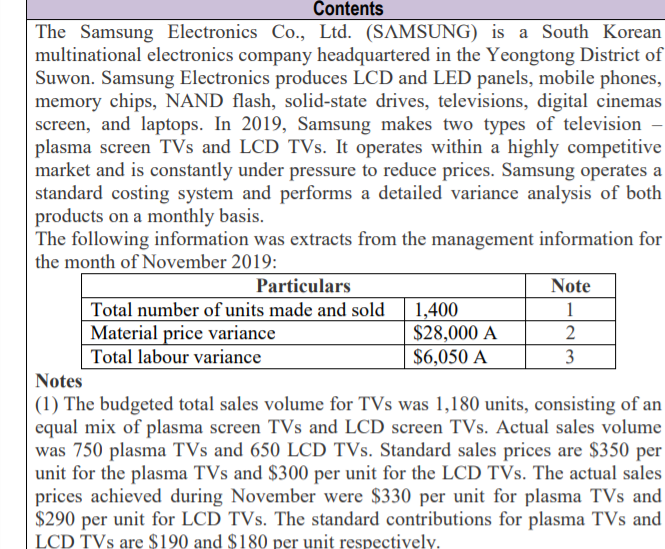Question
2) The sole reason for this variance was an increase in the purchase price of one of its key components, X. Each plasma TV made

2) The sole reason for this variance was an increase in the purchase price of one of its key components, X. Each plasma TV made and each LCD TV made requires one unit of component X, for which Samsung Cos standard cost is $60 per unit. Due to a shortage of components in the marketplace, the market price for November went up to $85 per unit for X. Samsung Co actually paid $80 per unit for it. (3) Each plasma TV uses 2 standard hours of labour and each LCD TV uses 15 standard hours of labour. The standard cost for labour is $14 per hour and this also reflects the actual cost per labour hour for the companys permanent staff in November. However, because of the increase in sales and production volumes in November, the company also had to use additional temporary labour at the higher cost of $18 per hour. The total capacity of Samsungs permanent workforce is 2,200 hours production per month, assuming full efficiency. In the month of November, the permanent workforce was wholly efficient, taking exactly 2 hours to complete each plasma TV and exactly 15 hours to produce each LCD TV. The total labour variance therefore relates solely to the temporary workers, who took twice as long as the permanent workers to complete their production. Required: The management of Samsung Electronics Co., Ltd. wants to take important decision on materials, labour and sales based on the variances. Hence, the management asked you to compute all possible variances and state the significance of each calculated variance for taking best decision.
Contents The Samsung Electronics Co., Ltd. (SAMSUNG) is a South Korean multinational electronics company headquartered in the Yeongtong District of Suwon. Samsung Electronics produces LCD and LED panels, mobile phones, memory chips, NAND flash, solid-state drives, televisions, digital cinemas screen, and laptops. In 2019, Samsung makes two types of television - plasma screen TVs and LCD TVs. It operates within a highly competitive market and is constantly under pressure to reduce prices. Samsung operates a standard costing system and performs a detailed variance analysis of both products on a monthly basis. The following information was extracts from the management information for the month of November 2019: Particulars Note Total number of units made and sold 1,400 1 Material price variance $28,000 A 2 Total labour variance $6,050 A 3 Notes (1) The budgeted total sales volume for TVs was 1,180 units, consisting of an equal mix of plasma screen TVs and LCD screen TVs. Actual sales volume was 750 plasma TVs and 650 LCD TVs. Standard sales prices are $350 per unit for the plasma TVs and $300 per unit for the LCD TVs. The actual sales prices achieved during November were $330 per unit for plasma TVs and $290 per unit for LCD TVs. The standard contributions for plasma TVs and LCD TVs are $190 and $180 per unit respectivelyStep by Step Solution
There are 3 Steps involved in it
Step: 1

Get Instant Access to Expert-Tailored Solutions
See step-by-step solutions with expert insights and AI powered tools for academic success
Step: 2

Step: 3

Ace Your Homework with AI
Get the answers you need in no time with our AI-driven, step-by-step assistance
Get Started


